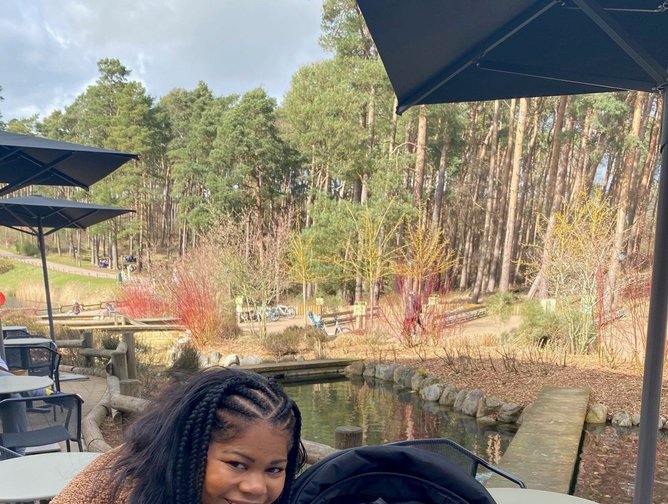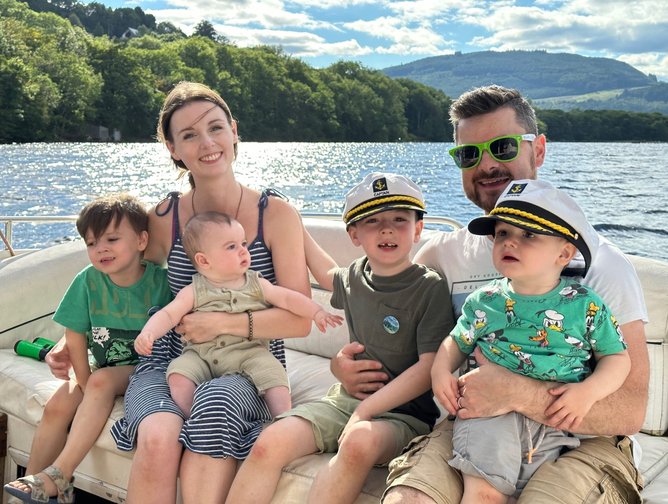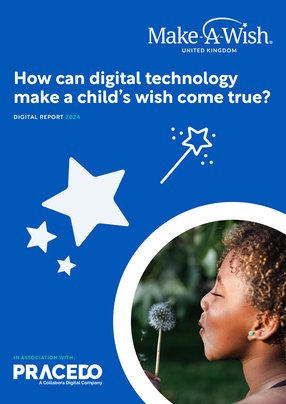How can digital technology make a child’s wish come true?
Sit with this point for a moment: “We granted 1,200 wishes for critically ill children last year. We estimate that we’d need to grant between 6,000-8,000 wishes every year to reach every child”. This is the importance of scale at Make-a-Wish UK in the words of its Director of Finance & Technology Sarah Watson.
If the resources were available, the organisation could achieve its vision of a wish for every eligible child.
This is one of the key points to highlight the importance of her position within the charity, and the need for its team to innovate and deliver new ways of working. Not only does this require monetary support, but information and guidance as to how Make-a-Wish UK can journey into the digital era and reap the benefits of everything technology has to offer.
While this is something of a hot topic at Make-A-Wish UK, there is still so much more the charity can do to ensure that all eligible children experience the magic of a wish, having missed out on new experiences, significant moments with their families, and other key aspects of childhood.
Summarised beautifully by Watson herself: “A wish brings magic, hope, and that real sense of childhood, because when a child’s diagnosed with a critical illness, the world says ‘no’ to them. It’s ‘no’ to parties, activities, and friendships. These joyful moments are replaced by hospital visits and difficult conversations—often adult conversations.”
“We have children with us who are critically ill and we have to ensure that our wishes can map to their timelines, whether that's around school, treatment, but also prognosis. So we have rush wishes, which are children whose prognosis is under six months, and we've seen a threefold rise in those since the pandemic.”
Taking the pressure off the beneficiaries of Make-a-Wish UK services
Watson plays a key role in the leadership team with a focus on finance and technology, which are intrinsically linked to scaling wishes for Make-a-Wish UK. Sarah not only has a key role at a strategic level, she also takes part in the wish granting process as a wish maker, helping children to discover what their wish could be. Being part of a small leadership team and playing a role in making those wishes come true is where we begin to understand the link between community and technology.
“When I came in, it was a new role for the organisation, specifically focused on digital as well as finance at that point,” says Watson. “That really was a huge part of the change needed: convincing people that it was okay to think differently; that we would be able to do this. We weren't suddenly going to have to take two steps back and close the doors and disappoint children because for us, the first responsibility is to our wish children.”
Watson is referring to the digital capabilities of Make-a-Wish UK and, ultimately, the ability to meet the needs of children with unique wishes—the organisation cannot simply follow a standardised approach if it is to grant a wish as unique as the child who is making the wish. Instead the team recognised the opportunity for digital to support the admin of wish with a different approach to wishes, enabling through digital a wish to ask for what it needed by embedding a stock management system. This new way of working generates requirements which can be fulfilled by cash or through a gift in kind donation of goods or services directly to a wish.
It seems the charity has recently come to the end of what Watson calls a “big bang transformation”; the initial digital overhaul that moved away from external support providers and created a full 360-degree view of a wish. As it follows in the footsteps of many other digitally enabled teams, Make-a-Wish UK leverages the Microsoft environment across its workforce and to communicate and enable volunteers. Working with the basics of cloud-based services has enabled greater collaboration within the team through Microsoft services like SharePoint, as well as leveraging Salesforce in a unique way.
Watson recognised the need to design for uncertainty, recognising that wishes may need to be granted more quickly as children's prognosis changed and the way that wishes were resourced through gifts in kind rather than cash, needed very different supporting infrastructure. Moving to an iterative way of working focused on continuous improvement ensures teams are focused on granting wishes enabled by technology.
“We've recognised that for us, the iterative way of working is really important to ensure our teams are enabled effectively by technology,” Watson says. “We are looking at design, making sure that privacy is embedded by design, ensuring that all the processes that can be are seamlessly integrated with changes that users want to see.”
Salesforce became the platform that led Make-a-Wish UK down an operational route inspired by commerce as Watson explains the approach to building a ‘virtual marketplace for wishes’. To enable this approach to be successful, the charity is building a network of individuals and organisations that support wishes aligned to its values—these are to be magical, inclusive and inspiring.
Unorthodox systems for a unique organisation
“A big part of the transformation was also thinking about how to embed a stock management system into Salesforce and actually almost commoditise a wish, which sounds like a really strange thing to say. All that meant was, if we know that a child wants to be an elf or they want to be Spiderman for the day, there's going to be certain things in that wish that are common. Potentially what they want to be is different, but there will be certain things that are the same,” says Watson.
She continues: “We wanted to build something that was a virtual marketplace that a wish could ask for what it needed so that someone who was at home, you could sit there and say, do you know what? I've got a horse and carriage on my drive. You can use it for the Princess wish on Friday. You would know about it because our Salesforce system could push that requirement out.
“We worked really hard to make sure we’ve got a 360-degree view of a wish; that we’ve got the connectivity, and the donor or supporter journey that really plays to our values.”
Working on this led Make-a-Wish UK to its partnership with JPMorgan and its Force for Good programme, which is helping bridge the technology solutions and skills gap in areas where it is needed most.
“We are really working short term, but also much longer term, because we recognise that if we want to work in a different way, and this has been a really big part of the transformation, we must find partners who can work with us on a pro bono basis,” says Watson.
Make-A- Wish UK have worked with Pracedo for a number of years, Pracedo have supported the evolution and development of the Salesforce platform that supports Wishes and Income. Despite some challenging moments, the organisation has witnessed great efficiency gains in ways of working.
“We have a very small internal team, and so we do need external expertise to support us,” explains Watson. “What we needed to do was bring all the technical knowledge of architecture and structures and how to use something creatively into alignment with what we did in terms of wishes, because that's a skillset partners don't tend to have.”
Technology is what drives efficiency, and Watson knows that, but she also explains that it’s important to understand the organisational requirements before venturing down any digital-solution rabbit holes. Not only can this be overwhelming when shifting to a technology-driven system, but it also prevents over-complication of specific tasks.
“Sometimes that can simply look like replicating a process in an automated way, but actually if you don't have the skill sets to understand how that can support or change the way you're working, you just end up with the same process. You’re just clicking buttons to do it rather than with a piece of paper,” says Watson. “That’s not effective, that’s not efficient.
“It took a while to really get into those design discussions and also observe areas where digital really could make a difference versus where we are dealing with lots of children's data. There’s a lot of safety, security; GDPR attached to that where actually there were really good reasons to work in a prescriptive way.”
Accepting donations via Cryptocurrency
What puts Make-a-Wish UK on the modern digital map is its ability to accept cryptocurrency as payment for donations. Of course dealing in bitcoin and other crypto can be seen as risky business—particularly when regulation is behind on such technologies—but Watson is confident that Make-a-Wish UK can leverage crypto as a means of funding from potential donors.
This piece of the puzzle was plucked from Chief, a women’s business network, where Watson took inspiration from discussions with her peers about technology and cryptocurrency.
She explains: “The financial services industries, the Financial Conduct Authority, and all the legislative bodies are looking at what they do to regulate this. But we also knew the potential for this was huge and what we wanted to be able to do was to see what was possible.”
In the same breath, she also mentions that digital assets could be valuable to the organisation, opening up a group of crypto philanthropists
“It wasn't easy because, equally, the press and PR around this hasn't been great. There aren't many good news stories about this, but if you look globally about what happens in the world where you've got currencies that can be worth something one day and they're not the next, there is space for digital assets because they don't move in the same way.
As can be expected—with minimal resources and a need for high levels of compliance—Make-a-Wish UK is collaborating with Zodia Custody and Zodia Markets to make this safe and secure.
Charting a course for digital enablement
To fulfil its strategy of scaling to reach every child eligible for a wish, Make-a-Wish UK puts technology at the top of the agenda from an operational perspective.
As time moves on, Make-a-Wish UK will leverage its close relationships with partners such as JPMorgan and Pracedo to build upon its digital capabilities. Particularly when it comes to data—which underpins everything the charity does—all of the ways in which donors and partners interact with that data, such as the website and other services, will develop to meet growing demands from users as well as regulatory changes.
“If your data isn't in good shape and you don't understand how it all links together, it's never going to be an optimum output. So, we're really focusing on data and how that drives things forward. The other area for us that's incredibly important is volunteer engagement—how we bring together communities of people to grant wishes in their local area, equip them with the tools that they need, and back to some of our earlier conversations around making sure they've got the skills and the confidence.”
Digital technology once again enables more and, in this case, ‘more’ means giving back to those who can really benefit down the line.




******
Make sure you check out the latest edition of Technology Magazine and also sign up to our global conference series - Tech & AI LIVE 2024
******
Technology Magazine is a BizClik brand


